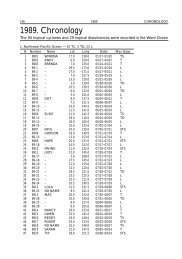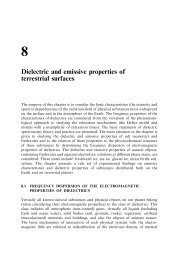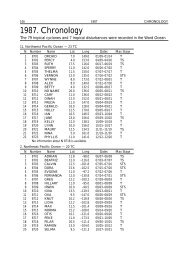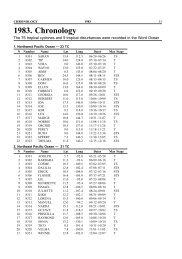Программа и тезисы докладов - Институт космических ...
Программа и тезисы докладов - Институт космических ...
Программа и тезисы докладов - Институт космических ...
Create successful ePaper yourself
Turn your PDF publications into a flip-book with our unique Google optimized e-Paper software.
The participants of the acceptance tests are the representatives of Special Design<br />
Office of Space Instrument Making and those of QC (quality control) and the<br />
Research Laboratory of avia-apace techniques. Acceptance tests involved 19 categories<br />
of tests performed with the use of 16 types of equipment and devices. The operating<br />
experience of the MS has indicated that 7 operations are insufficient for such a<br />
compound complex as microsatellite “Chibis-M” that is meant, as it is important to<br />
point out, for conducting fundamental space investigations.<br />
ground SegMenT and operaTionS For MicroSaTelliTe “chibiS-M”<br />
В. Nazarov 1 , R. Nazirov 1 , L. Zelenyi 1 , V. Angarov 2 , O. Batanov 1 , †L. Bodnar 4 ,<br />
N. Eismont 1 , V. Gotlib 1 , V. Karedin 2 , S. Klimov 1 , F. Korotkov 1 , I. Kozlov 1 , A. Ledkov 1 ,<br />
A. Melnik 1 , A. Papkov 3 , V. Rodin 1 , A. Ryabova 1 , Ya. Shmelauer 5 , A. Tretiakov 1<br />
1<br />
Space Research Institute of Russian Academy of Russian, IKI RAN, Moscow, Russia<br />
2<br />
SKB KP IKI RAN, Tarusa, Moscow, Russia<br />
3<br />
NILAKT ROSTO, Kaluga, Russia<br />
4<br />
Budapest University, Hungary<br />
5<br />
UFA CAZ, Prague, Czech Republic<br />
The microsatellite “Chibis-M” is in flight operations stage now. Its flight story<br />
starts on November 2, 2011 when cargo ship “Progress M-13M” was docked with<br />
International Space Station (ISS). As usually it brings some equipment and goods<br />
needed for ISS survival but also it delivered microsatellite “Chibis-M”. At January<br />
24, 2012 01:59 msk “Progress M-13M” was undocked and after two corrections<br />
it will be positioned at 500 km orbit. At January 25, 03:14 msk “Chibis-M” was separated<br />
from it and starts its own flight.<br />
The mass of the microsatellite, is 34.4 kg, the mass of scientific instruments on<br />
board is about 12 kg. The one of distinctive features of the microsatellite “Chibis-<br />
M” is that it is assigned not for education proposes only but for investigation in the<br />
field of fundamental researches as well.<br />
The main purpose of “Chibis-M” is a comprehensive study of physical processes<br />
in atmospheric lightning discharges in a wide range of energies — from radio<br />
to gamma radiation as well as extended measurements of parameters which may be<br />
described by term called “space weather”. And it contains an impressive list of the<br />
scientific instruments for resolving these tasks of course.<br />
Extended measurements means using of high-speed telemetry channels which<br />
requires respective power supplying. And it corresponds to some problems for relatively<br />
small spacecrafts. Therefore three downlink and one uplink systems where<br />
used onboard the microsatellite.<br />
High speed S-band channel which provides downlink for science data in format<br />
of CCSDS telemetry packets up to 1 Mbps. For technical mission operations<br />
radio-amateur bands are used with frequencies of 145 and 435 MHz for uplink and<br />
downlink respectively. For preventing of collisions with radio-amateurs and for<br />
safety reasons this links use respective security coding. And at last the telegraph<br />
channel with simplest coding by dot-and-dash (Morse code) method is used for<br />
transferring information about the general status of the satellite.<br />
Such architecture of the satellites links as well as using of modern technologies<br />
(like Web 2.0, SOA, etc.) and implementation of a few new approaches allowed us<br />
21

















